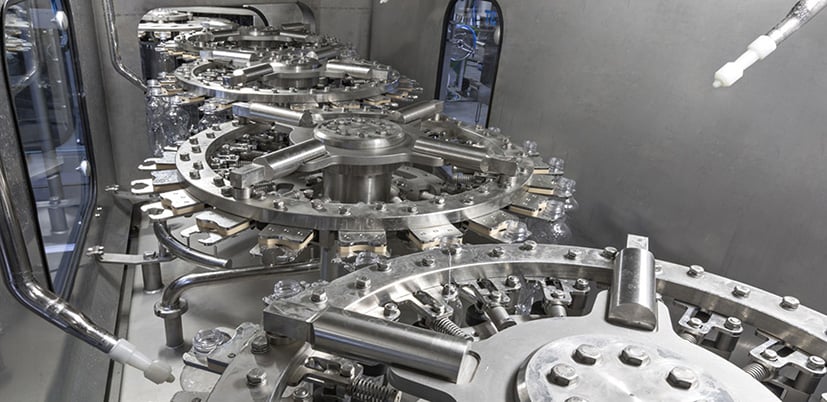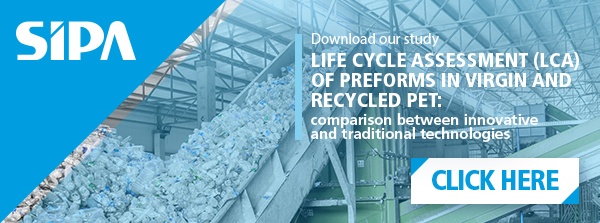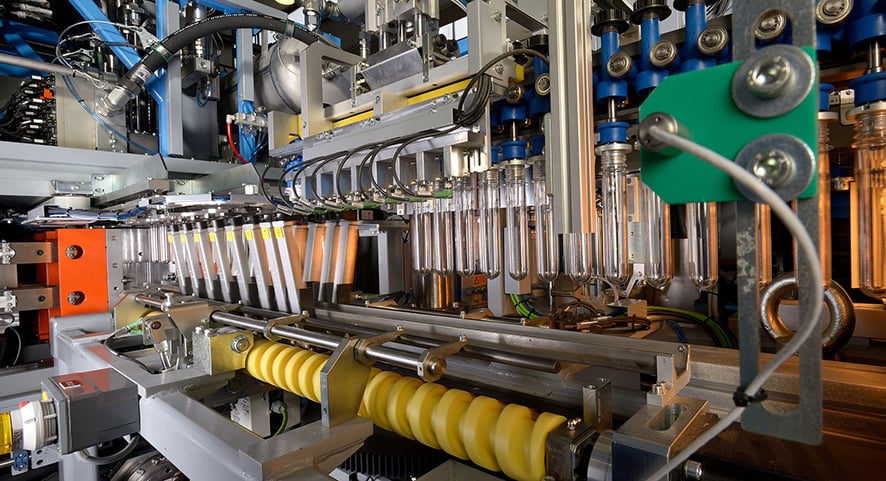Technology applied to the PET packaging sector has allowed considerable development as regards the progressive implementation of integrated lines, starting from the so-called traditional systems.
As regards bottling of liquids, optimisation of the lines started with integration between rotary blower and filling/capping unit, which has become a widely used market standard, moving on to lines that include preform production, labelling, all the way to integrated boxing, bundling and palletizer solutions for secondary packaging.
How the basic rotary blower-filling unit systems work
Traditional systems, consisting of rotary blower and filling unit, involve different integrated phases:

- Preform feeding
This starts from the elevator belt using which the preforms are carried from the feeder hopper to the orienting device. The latter inserts them into a sloped guide from which, by gravity, they reach the spacer wheel located at the entrance to the heating module. The wheel feeds the rotary spindles chain, using which the preforms are picked up, entering the heating module.
- Preform heating
In many systems, before the preforms enter the heating module each preform is subjected to tests to check their dimensions and vertical position, eliminating those that do not comply with the pre-set parameters. The preforms then move along the heating module. During the whole process the preforms rotate around themselves, so as to guarantee optimum, symmetrical heat distribution.
READ ALSO: "100% customised solutions to create aesthetically perfect PET containers" - Preform stretching-blowing system
A rotary gripper unit picks up the preforms and positions them inside stretching/blowing molds. The stretching/blowing process is divided into two phases: stretching and pre-blowing, by lowering the stretching rod and input of compressed air at low pressure, then blowing proper using high pressure compressed air, through which the containers take on their final shape.
The finished bottles are picked up using a second rotary gripper unit, put onto an air conveyor belt and finally carried to the filling system.
- Filling process
The liquid to be bottled is stored in a tank that can be external or on board the machine, from which it reaches the filling valves which can be gravity for still liquids or isobaric for carbonated products.
Filler can be mechanical level or electronic volumetric with magnetic or mass flow meters, or in some specific cases by weight using load cell. For more modern electronic filling machines, once the filling has started, the measuring system defines with extreme precision the amount of product passing through the valve, which is set according to the size being processed. When the set value is reached, the signal to close the filling valve is sent to the filling machine.
- Capping
Completion of the process in basic models of integrated line coincides with the phase in which the full bottles are transferred to the capping machine by means of a star wheel equipped with special grippers. The caps are turned to the correct direction by a lifter/orienting device and are transferred to the device that applies the cap to the neck of the bottle with a rotating capping head.

Introduction of the linear blower
Some suppliers - although not many - looking to technological innovation have introduced the first integrated systems that combine a linear blower with a rotary filling unit.
These innovative systems with linear blowing allow great flexibility in the production of various types of container and different products: standard and customised containers for standard and hot filling, oval containers and jars, and also large containers of up to 30 litres.
They are undoubtedly a great step forward in the processes for production and filling of large sizes.
Read Also: "Integrating a linear blower with a rotary filling unit in PET bottling systems"
The integration of the labelling machine
Moving on to development of increasingly new solutions, the market currently offers an integrated system composed of blowing, labelling, filling and capping.
This solution is undoubtedly excellent in terms of compactness, and is able to optimise both investment and operating costs (single operator, less energy, optimised logistics, lower management costs).
To this must be added increased performance and medium-high quality, particularly as regards labelling: the bottles are always dry (no formation of condensation) and the solution guarantees the same label application quality throughout the whole cycle.
The brand-new integrated lines with PET preform production
The next step was the one regarding integration of preform production into the PET liquid bottling lines, although there are still very few suppliers able to connect a preform production system to a blower, which in turn is connected to a filler, and gua
rantee a customized project that is suited to customer needs.
In any case this is a system that can be used for all types of product: still and sparkling, cold filling and hot filling, with and without pulp, sensitive products, including preservative-free CSD, and products with a high added value.
The end result is a compact, flexible and ene
rgy-efficient line, with the additional advantage of eliminating preform management.
Over the years, integration has naturally also been applied to secondary packaging, with examples of introduction into the various lines of shrink-wrappers and palletising systems, between the cartoning phase (formation of American type carton, case packers, carton sealer) and the palletising process.







